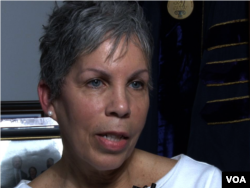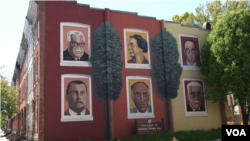Last month's riots in Baltimore, Maryland, over the death of a black man fatally injured in police custody highlighted the deep-rooted socioeconomic problems afflicting many American post-industrial cities.
Two African-American women who grew up in West Baltimore, epicenter of the unrest, talked about the area’s rich history, the rioting's impact and their hopes for a civic turnaround.
One is Linda Kees, who with her husband is raising three daughters. The other is Bronwyn Mayden, who with her husband has two grown sons. Kees, 35, works as a parent mentor for Promise Heights, an academic-community partnership in Upton/Druid Heights, one of the city’s poorest neighborhoods. Mayden, 62, directs the Promise Heights program — which supports youngsters from infancy to adulthood — and serves as the University of Maryland School of Social Work’s associate dean.
Caught in the crossfire
Kees lives in Druid Heights, where some of the rioting took place. It’s part of West Baltimore, where drugs, violence and crime have long been a part of life.
She recalls getting “caught up in a shootout — meaning they was shooting at each other — but they really weren’t that far away from me,” Kees said. That was long before she had kids; her oldest, Delteona, is 14.
But even today, "I hear plenty of shooting where I live now," she added, and it keeps her watchful for her family.
Kees rarely lets her children out of sight when they are outdoors, and she herself barely leaves home at night. "I didn’t go out when the rioting was going on," she said.
She hopes that one day she and husband can afford to move the family to a safer neighborhood.
"I just want to change environments for my children where they don’t have to go outside every day and see people standing on the corner or just see people out there with [alcoholic] drinks in their hand," Kees said this week.
Her neighborhood, scarred with vacant housing, had a better past. It was once a thriving African-American middle-class community.
A proud history
Mayden admits she "can barely remember" that period, but she speaks of it proudly.
"This is a community where civil rights leaders were born. They went to school there. Many jazz greats [like] Billie Holliday lived there and performed there," she said. "I know that it was a very vibrant community. A lot of energy, a lot of creative forces were there…."
But conditions declined as better-paying industrial work began disappearing in the 1950s.
News of the assassination of civil rights leader Martin Luther King Jr. in April 1968 led to an eruption of violence in Baltimore and in other American cities. Riots broke out along Baltimore's Pennsylvania Avenue, near where the recent disturbances took place.
After the 1968 riots, the character of the neighborhood began to change. “It became a scar right down the middle of West Baltimore,” said Mayden, who knows the area both personally and professionally.
From 1950 to 1995, the city lost 100,000 manufacturing jobs — 30,000 alone from Bethlehem Steel, once the largest steel plant in the country. More than 200,000 people left the city for the suburbs.
The loss of jobs and people crippled the West Baltimore neighborhood, Mayden said: "You could buy a house if you worked for Beth Steel. Now, however, you have to have a college degree, or even higher than a college degree, if you are going to work in the top job places in Baltimore."
The area’s largest employers primarily include universities and health care institutions, some of which are affiliated, the Baltimore Development Corp. website shows.
Seeking solutions
Mayden described those who took part in the recent violence as children crying out for a better life.
"They have been living in these housing projects and these homes with parents, some of whom are substance abusers, some are in prison," she said. "You see the anger and the frustration, and they are asking of us, and demanding of us, to come up with some solutions."
The program she directs, Promise Heights, tries to provide some by working with five community schools and their families in the neighborhood. It has 26 community partners, including those from local governments and nonprofit organizations, helping with health care, housing issues, social services and much more.
Part of the solution, said Kees, is parenting a generation of children with stronger core values.
"That’s why I say, 'It is not where you live, it is how you live,' " Kees said. "I am trying to teach them: Go the other route. We are not going down this road."

